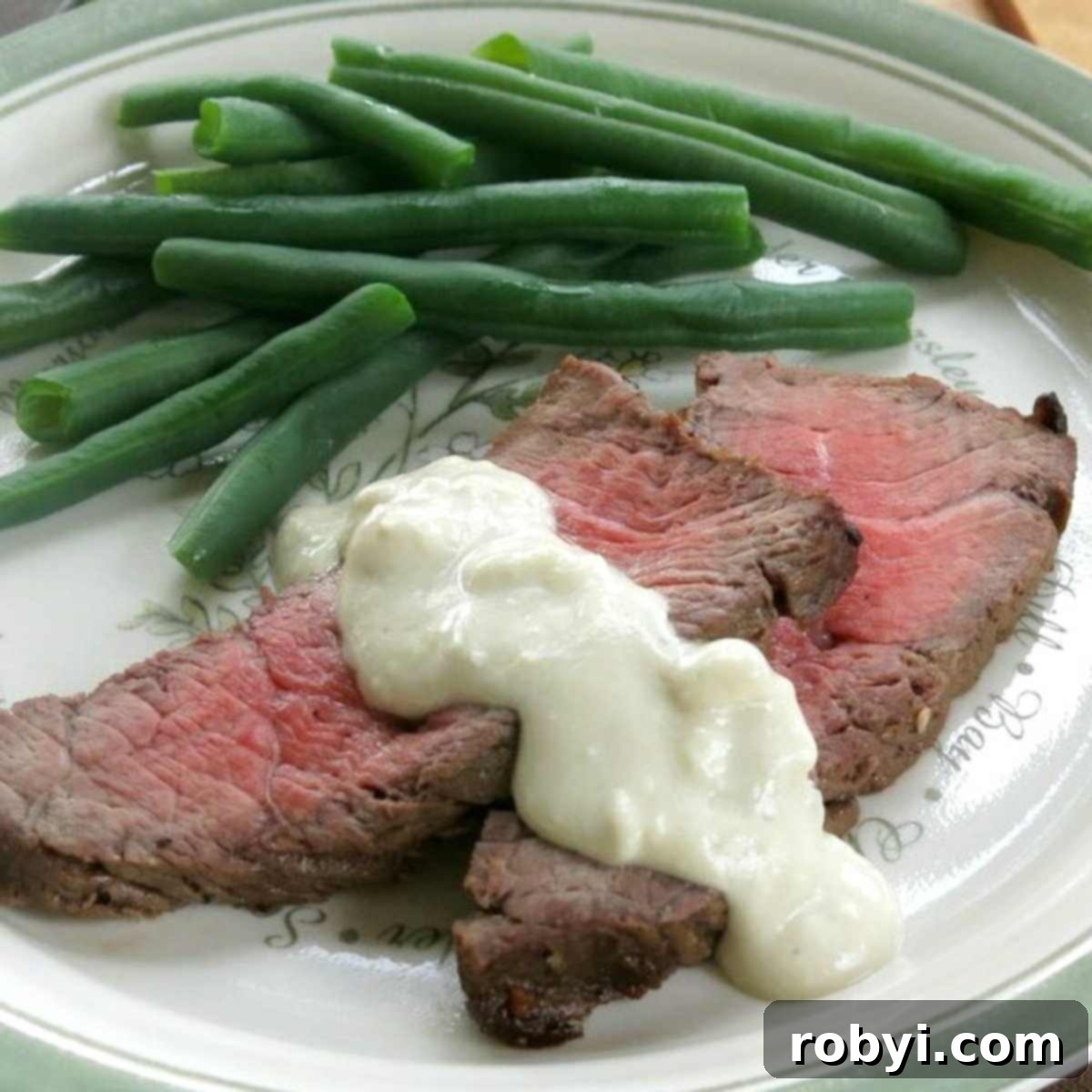Unlock the secrets to crafting the most **tender and juicy London Broil in your oven** with this comprehensive guide! It’s a bold promise, but the techniques, expert tips, and incredibly flavorful marinade detailed here have been honed and perfected by thousands of satisfied customers at our Make-Ahead Meal Kitchens, ensuring a consistently delicious steak experience every single time.
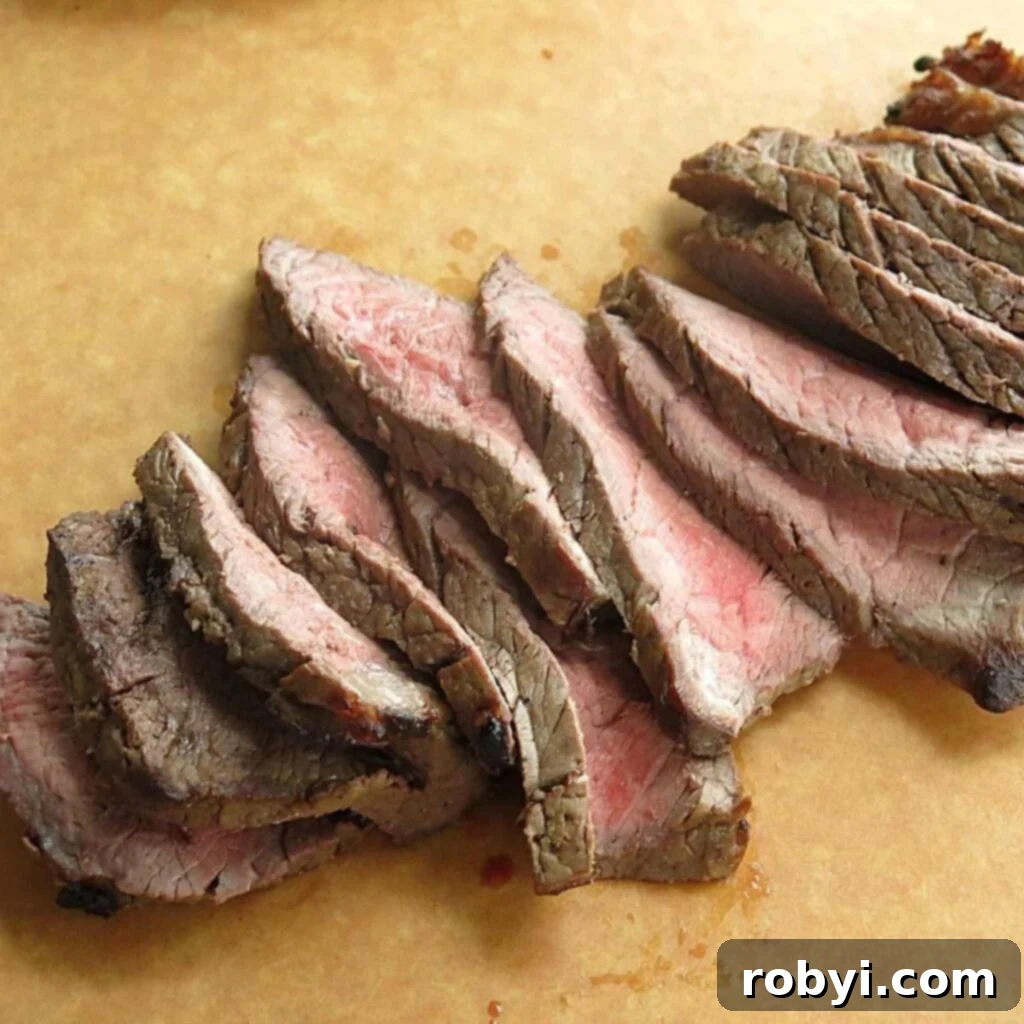
This classic recipe seamlessly integrates into your weekly dinner planning. Prepare it for a delightful meal one evening, and easily prep a second portion for the freezer, saving you valuable time on busy days. Plus, plan for delicious leftovers to effortlessly create quick and tasty fajitas, vibrant steak salads, or hearty steak sandwiches the following night.
This article is your ultimate resource, brimming with invaluable advice and versatile marinade ideas designed to transform even leaner cuts of beef, like top sirloin or flank steak, into an outstanding London Broil that is both tender and incredibly flavorful, without fail.
What is London Broil? Unraveling the Misconception
This question was incredibly common at our kitchens, and for good reason! Many people assume London Broil is a specific cut of beef, but it’s actually a culinary term describing a particular **preparation method** for tougher, leaner cuts of meat. It involves marinating, broiling (or sometimes grilling/baking) to a medium-rare or medium doneness, and then thinly slicing the cooked beef against the grain.
When you head to the grocery store to make this recipe, you’ll want to look for cuts like **top round steak** or **flank steak**. These cuts are ideal because they are lean, boast a rich beefy flavor, and respond beautifully to the tenderizing marinade and quick, high-heat cooking methods that define London Broil. Occasionally, you might also find cuts like sirloin tip or even flat iron steak marketed for London Broil.
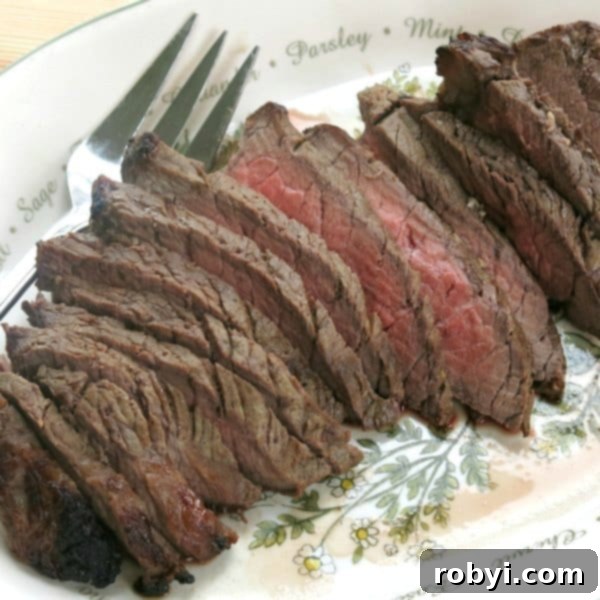
The Secret to Tender London Broil: Mastering Tenderization
The key to an unforgettable London Broil lies in proper tenderization. Cuts like top round and flank steak are inherently lean, meaning they have less fat marbling, and longer, tougher muscle fibers. Without proper care, they can easily become tough and chewy. Our strategy combines both mechanical and chemical tenderization for optimal results.
Here are the essential steps to ensure your London Broil is incredibly tender:
- Mechanical Tenderization: Before marinating, lightly puncture the surface of the meat with a fork or, for more significant tenderization and to even out thickness, pound it with a meat mallet. This physically breaks down some of the muscle fibers, allowing the marinade to penetrate more deeply and work its magic more effectively.
- Acidic Marinade: Utilize a marinade rich in acidic ingredients. Acids, like those found in red wine vinegar and lemon juice (both staples in our recommended recipe!), chemically break down connective tissues in the beef, resulting in a noticeably more tender texture.
- Optimal Marination Time: Allow sufficient time for the marinade to work. While 2 hours is the minimum, 4 hours is better, and an overnight soak delivers maximum flavor and tenderization.
- Cut Against the Grain: After cooking, it is absolutely crucial to slice the meat **across the grain**. This shortens the muscle fibers, making each bite much easier to chew and preventing a stringy texture. We’ll delve deeper into this technique below.
- Perfect Cooking Temperature & Doneness: Avoid overcooking! Lean cuts dry out quickly, becoming tough. Aim for medium-rare to medium doneness, carefully monitoring the internal temperature.
- Rest the Meat: Never cut into a steak immediately after cooking. A resting period allows the juices to redistribute throughout the meat, resulting in a juicier, more tender final product.
Crafting the Perfect Marinade for Flavor and Tenderness
Our signature London Broil marinade is designed to infuse incredible flavor while ensuring maximum tenderness. This recipe yields approximately 1 cup of marinade, perfect for 2 pounds of London Broil or similar beef cuts. Easily double or triple the recipe as needed for larger quantities.
- Canola Oil or Avocado Oil: Acts as a carrier for fat-soluble flavors, helps to brown the meat, and keeps it moist during cooking.
- Soy Sauce (or Coconut Aminos): Provides essential umami, savory depth, and saltiness. For a soy-free alternative, Coconut Aminos are an excellent substitute.
- Red Wine Vinegar: A crucial acidic component that tenderizes the meat by breaking down tough muscle fibers. It also adds a bright, tangy note.
- Lemon Juice: Another powerful acidic agent that aids in tenderization and brightens the overall flavor profile.
- Worcestershire Sauce: Offers a complex, savory, and slightly tangy flavor. For a soy-free marinade, you can omit this or find a soy-free alternative.
- Ground Mustard: Adds a subtle piquancy and helps to emulsify the marinade, ensuring flavors are well distributed.
- Freshly Ground Black Pepper: Provides a hint of spice and aromatic warmth.
- Minced Garlic: Essential for a robust, aromatic base flavor that permeates the meat.
This versatile marinade can be mixed in advance and stored in the refrigerator for up to a week in a sealed glass jar, making it an excellent component for your meal prep routine.
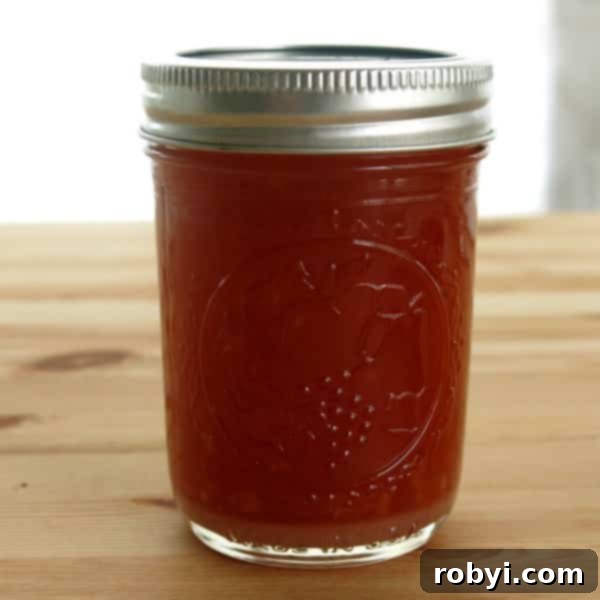
Optimal Marination Times and Techniques
For London Broil or any lean beef cut, we strongly recommend marinating for a minimum of 2 hours in the refrigerator. However, to truly allow all the rich flavors to deeply penetrate the meat and achieve maximum tenderization, 4 hours is preferable, and an overnight marination (up to 24 hours) will yield the most outstanding results.
The simplest and most effective way to marinate beef is to place it in a sturdy, resealable plastic bag with the marinade. This method allows you to easily turn the bag periodically, ensuring all surfaces of the meat are evenly coated and soaking in the delicious flavors. If you prefer not to use plastic, a shallow glass baking dish works equally well, just ensure you flip the meat occasionally.
Pro Tip for Plastic Bags: When using the plastic bag method, always place the sealed bag inside another plastic bag or a baking dish. This precautionary step is invaluable for containing any potential leaks and preventing cross-contamination in your refrigerator.
Crucial Safety Reminder: Always marinate raw meat in the refrigerator, never at room temperature on the kitchen counter. This prevents the growth of harmful bacteria and ensures food safety.
While marinating should be done in the cold, it is a good practice to allow your London Broil to come to room temperature before cooking. Remove the marinated steak from the refrigerator approximately one hour before you plan to cook it. This ensures more even cooking and helps prevent the meat from seizing up when it hits the hot broiler, resulting in a more tender steak.
Broiling London Broil in the Oven (The Preferred Method)
Broiling is widely considered the best method for cooking London Broil in the oven because it mimics the intense, direct heat of a grill, creating a beautiful crust while keeping the interior juicy. The exact cooking time will vary based on the thickness of your meat and your desired level of doneness. Top round steaks typically range around 1 inch in thickness, while flank steaks are often a bit thinner.
Before You Begin:
- Remove the marinated beef from the bag or dish and discard all excess marinade. It cannot be reused due to contact with raw meat.
- Position your oven rack within 3 to 4 inches of the heating element (the broiler).
- Preheat your broiler for at least 5-10 minutes. This ensures the element is intensely hot, essential for a good sear.
- Place the meat on a broiler pan (lightly sprayed with non-stick cooking spray to prevent sticking). A broiler pan allows air to circulate and fat to drain, preventing steaming.
Cooking Process:
Cook the London Broil for a total of 14 – 20 minutes, flipping it halfway through. For a 1-inch thick steak and if you are less accustomed to broiling beef, a good starting point is to flip the steak at the 7-minute mark. Begin checking for doneness around 14 minutes and adjust based on your preference.
Achieving Perfect Doneness:
The USDA recommends cooking beef to an internal temperature of 145°F for food safety. However, for a more pink center, here are common internal temperatures:
- Rare: Approximately 125°F (with a very red, cool center)
- Medium-Rare: Approximately 130-135°F (with a warm red center)
- Medium: Approximately 140-145°F (with a warm pink center)
Always use a reliable meat thermometer inserted into the thickest part of the steak to accurately gauge doneness. Remember that meat will continue to cook a little (known as “carry-over cooking”) after it’s removed from the oven, so take it out about 5 degrees before your desired final temperature.
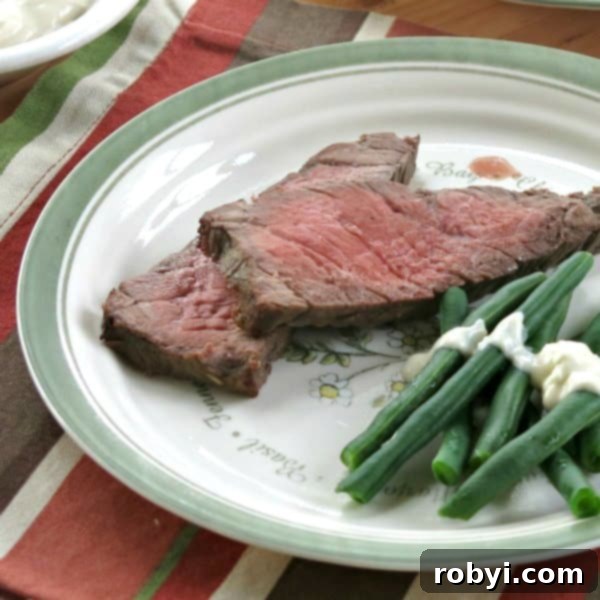
Baking London Broil for a Milder Cook (350 °F Oven)
While broiling is our top recommendation for the classic London Broil experience, you can also bake London Broil in a 350°F (175°C) oven. This method offers a more gentle, even cook, though it won’t produce the same crisp, caramelized crust as broiling. It’s particularly good for those who prefer a less aggressive cooking approach.
When baking at a lower temperature, it’s crucial to baste the meat frequently with some of the marinade (ensure it hasn’t touched raw meat if reusing, or use fresh marinade) or a simple pan sauce to prevent it from drying out. Lean cuts like top round can become dry if not properly managed.
Baking will typically take longer than broiling, possibly an additional 10 minutes or more, depending on the thickness of your steak and your desired doneness. Continue to use a meat thermometer to monitor the internal temperature for accuracy.
For enhanced flavor and texture when baking: Consider searing the London Broil first on the stovetop in a hot, oven-safe skillet for 2-3 minutes per side until a nice brown crust develops. Then, transfer the skillet directly to the preheated 350°F oven to finish cooking. This technique, known as reverse searing or pan-roasting, combines the best of both worlds: a flavorful crust from searing and even cooking from baking.
The Critical Resting Period and Slicing Against the Grain
These two steps are non-negotiable for a truly tender and juicy London Broil, perhaps even more so than for other steak cuts due to the inherent leanness of the meat.
The Resting Period:
Once your London Broil is cooked to your desired internal temperature, remove it from the oven (or grill) and transfer it to a cutting board. Cover it loosely with foil and **allow it to rest for at least 5 to 10 minutes**. This resting period is critical for several reasons:
- Juice Redistribution: During cooking, the muscle fibers contract, pushing juices to the center of the steak. If you cut into it immediately, these juices will spill out onto your cutting board, leaving you with dry meat. Resting allows the muscle fibers to relax and reabsorb those delicious juices, resulting in a significantly juicier steak. As The Spruce Eats explains, it’s a scientific process essential for a juicy outcome.
- Even Doneness: Carry-over cooking continues during resting, helping to finalize the doneness evenly throughout the steak.
Slicing Against the Grain:
After resting, the final crucial step is to slice the meat **against the grain**. This refers to cutting perpendicular to the direction of the muscle fibers. If you slice with the grain, the muscle fibers remain long and intact, making each bite incredibly stringy and chewy, no matter how perfectly you cooked it.
How to Identify the Grain: Look closely at the surface of your cooked steak. You’ll observe visible lines running in one direction – these are the muscle fibers. Your goal is to position your knife to cut directly across these lines. In the picture below, the muscle fibers run from left to right, so the meat is sliced perpendicularly, from top to bottom.
Slice the London Broil into thin pieces, typically about ¼ inch thick. Thinner slices further contribute to the tenderness and make the steak more enjoyable to eat.
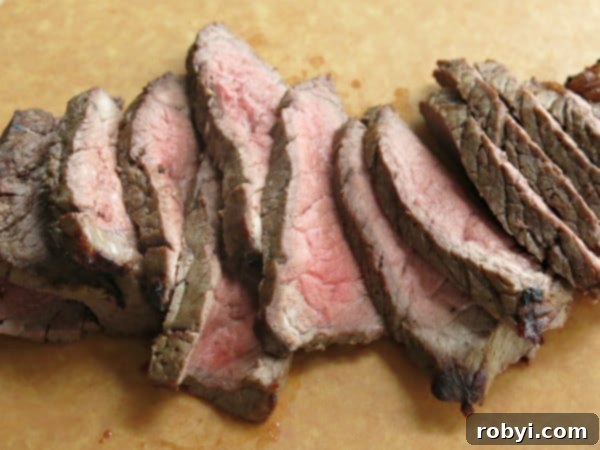
Grilling London Broil for a Smoky Flavor
If you’re a fan of the smoky char and distinct flavor that only a grill can provide, London Broil is an excellent candidate for outdoor cooking. The same tenderizing marinade and careful cooking principles apply to grilling.
Preparation for Grilling:
- As with oven broiling, remove the marinated meat from its bag or dish and discard all the excess marinade.
- Preheat your grill to high heat. For gas grills, aim for around 450-500°F. For charcoal grills, ensure the coals are glowing red with a light layer of ash.
- Lightly oil your grill grates to prevent the meat from sticking. You can do this by folding a paper towel, dipping it in a high-smoke-point oil (like canola or avocado oil), and using tongs to wipe it across the hot grates.
Grilling Process:
Place the London Broil directly on the oiled, hot grate. Cook for a total of 14 – 20 minutes, flipping halfway through. For a 1-inch thick steak, aim for about 7-10 minutes per side. Use the temperature guidelines mentioned above (130-135°F for medium-rare) and a meat thermometer to ensure perfect doneness.
You can also achieve beautiful grill marks by placing the steak down, letting it cook for 2-3 minutes, then rotating it 45 degrees for another 2-3 minutes before flipping to the other side. This creates a crosshatch pattern.
Once cooked, remember to let the meat rest for 5-10 minutes, covered loosely with foil, before slicing it thinly against the grain. This guarantees a juicy and tender result, full of smoky flavor.
Meal Prep: Freezing Marinated London Broil for Future Enjoyment
One of the fantastic advantages of London Broil is how well it lends itself to meal prepping, specifically freezing in its marinade. This technique allows you to save time on future busy evenings and ensures a flavorful meal is always within reach.
Simply prepare the marinade and combine it with your top round or flank steak exactly as you would if you were going to marinate it in the refrigerator for immediate cooking. For freezing, a heavy-duty, resealable plastic freezer bag is ideal.
Freezing Steps:
- Place the beef and marinade into the freezer bag.
- Seal the bag, making sure to press out as much excess air as possible. Removing air helps prevent freezer burn and maintains the quality of the meat.
- Label the bag clearly with the contents and date.
- Lay the bag flat in your freezer for easier stacking and faster freezing. It can be safely stored for up to 2 months.
Thawing and Cooking:
When you’re ready to enjoy your frozen London Broil, transfer the sealed bag from the freezer to the refrigerator and allow it to defrost overnight. A full 24 hours in the fridge is usually sufficient for complete thawing.
An amazing bonus of this method is that the London Broil will begin its marination process as it starts to freeze, and it will continue to marinate as it slowly defrosts in the refrigerator. This extended exposure to the marinade truly infuses the meat with flavor and tenderizes it even further, setting you up for an incredibly delicious steak with minimal effort on cooking day.
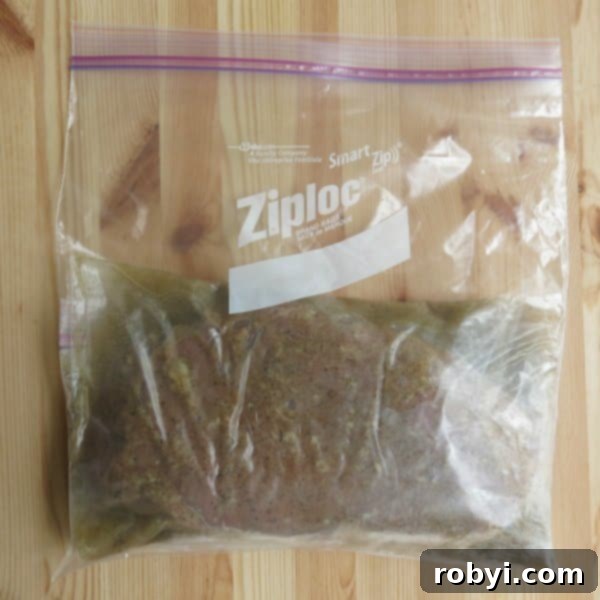
Delicious Serving Suggestions for London Broil
London Broil is a truly versatile dish that effortlessly fits into a casual weeknight dinner rotation but can also be dressed up to impress for special occasions like Valentine’s Day, New Year’s Eve, anniversaries, or any festive gathering. Its rich flavor pairs beautifully with a wide array of sides and sauces.
Our Favorite Topping Ideas to Elevate Your Steak:
- Easy Blue Cheese Sauce: This incredible 4-ingredient sauce delivers a creamy, tangy, and sophisticated flavor that tastes like it came straight from a gourmet steakhouse.
- Creamy Horseradish Sauce: (Recipe by A Family Feast) For those who love a bit of a kick, a classic creamy horseradish sauce offers a delightful zing that beautifully cuts through the richness of the beef.
- Buttery Steak Sauce: (Recipe by The Novice Chef) A rich, savory, and slightly sweet buttery steak sauce can add another layer of indulgence, enhancing the natural flavors of the London Broil.
- Fresh Herbs: A simple sprinkle of chopped fresh parsley, chives, or rosemary adds a pop of color and fresh aroma.
- Caramelized Onions or Sautéed Mushrooms: These classic steak accompaniments bring earthy, sweet, and savory notes that complement the beef perfectly.
Simple Yet Satisfying Side Dishes:
Complete your meal with a few easy-to-prepare side dishes that let the London Broil shine:
- Crispy Roasted Green Beans: A healthy and delicious green vegetable that provides a wonderful texture contrast.
- Sweet Corn on the Cob: Whether microwaved in the husk or grilled, corn adds a touch of sweetness and vibrant color.
- Fluffy Mashed Potatoes or Roasted Potatoes: Classic comfort food sides that are always a hit.
- Fresh Garden Salad: A light, crisp salad with a simple vinaigrette offers a refreshing counterpoint to the rich steak.
- Garlic Bread or Dinner Rolls: Perfect for soaking up any leftover juices or sauces.
- Asparagus with Lemon: A quick and elegant side dish that pairs wonderfully with beef.
With these suggestions, dinner is not just done, it’s a memorable experience!
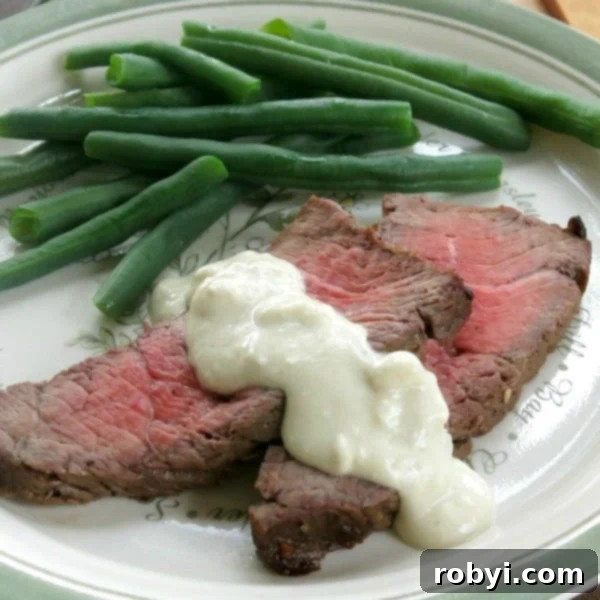
Frequently Asked Questions (FAQ)
Here are answers to some common questions about cooking London Broil:
Q: Can I use other cuts of meat for London Broil?
A: While top round and flank steak are traditional, you can also use sirloin tip, flat iron steak, or even skirt steak for a similar preparation. The key is to choose a lean cut that benefits from marination and thin slicing against the grain.
Q: What if I don’t have a broiler pan?
A: If you don’t have a dedicated broiler pan (which typically has a slotted top over a collection pan), you can place your steak on a wire rack set inside a foil-lined baking sheet. This allows fat to drip away and promotes air circulation, similar to a broiler pan.
Q: How can I tell if my steak is tenderized enough?
A: The best way to judge is by the texture after cooking and slicing. If you’ve followed the tenderizing steps (poking, acidic marinade, proper marination time, and cutting against the grain), you should achieve a tender result. If it’s still a bit chewy, it might be due to not resting long enough, slicing with the grain, or overcooking.
Q: Can I pan-fry London Broil?
A: Yes, you can! Heat a heavy-bottomed skillet (like cast iron) over medium-high heat with a tablespoon or two of oil until shimmering. Sear the steak for 3-5 minutes per side for medium-rare, adjusting for thickness and desired doneness. Finish with resting and slicing against the grain.
Q: How long can cooked London Broil be stored?
A: Cooked London Broil can be stored in an airtight container in the refrigerator for 3-4 days. It’s excellent for repurposing into salads, sandwiches, or fajitas. You can also freeze cooked London Broil for up to 2-3 months, though the texture might change slightly upon reheating.
Why London Broil Deserves a Spot in Your Kitchen
London Broil is more than just a recipe; it’s a smart cooking strategy for enjoying delicious, flavorful steak on a regular basis. Its reliance on more economical cuts of beef, combined with simple yet effective tenderizing and cooking methods, makes it an approachable and rewarding dish for any home cook.
Whether you’re planning a quick weeknight meal, preparing for a special gathering, or stocking your freezer with wholesome, ready-to-cook options, London Broil offers incredible versatility and consistent results. By following these tried-and-true techniques, you’ll master the art of creating tender, juicy, and perfectly seasoned steak every single time.
More Delicious Beef Recipes to Explore
If you’ve enjoyed mastering London Broil, you’ll love these other fantastic beef recipes. The marinades in the first two recipes, in particular, are also excellent choices for London Broil if you’re looking to experiment with different flavor profiles:
- Easy Bavette Steak Recipe (Pan-Sear on Stovetop)
- Red Wine Marinade for Steak Shish Kabobs
- Flank Steak Pinwheels (Oven)
Would you like more easy, healthy, carb-conscious recipes delivered straight to your inbox?
📋 Recipe: Best London Broil in Oven
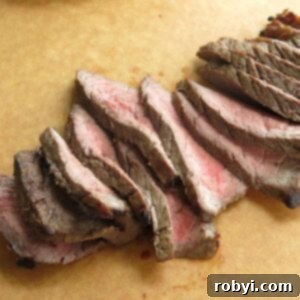
Best London Broil in Oven
Ingredients
- ▢ ½ cup canola oil or avocado oil
- ▢ ¼ cup soy sauce
- ▢ 2 Tablespoons lemon juice
- ▢ 2 Tablespoons red wine vinegar
- ▢ 2 Tablespoons Worcestershire sauce
- ▢ 1 Tablespoon ground mustard
- ▢ 1 teaspoon pepper
- ▢ 2 garlic cloves minced
- ▢ 2 pounds top round steak or flank steak
Instructions
- In a resealable plastic bag or a small bowl, combine all the marinade ingredients.
- Add the beef to the marinade. Marinate in the refrigerator for at least 2 hours, and ideally up to 24 hours, flipping the bag or meat several times to ensure even coating.
- Remove the beef from the marinade and discard any excess marinade. Allow the steak to come to room temperature for about 1 hour before cooking for best results.
- Preheat your oven broiler and position the oven rack 3-4 inches from the heating element.
- Place the beef on a broiler pan (or a wire rack set in a baking sheet) and cook for approximately 7-10 minutes on each side, or until the meat reaches your desired doneness (e.g., 130-135°F for medium-rare). Use a meat thermometer for accuracy.
- Transfer the cooked meat to a cutting board and let it rest, loosely tented with foil, for about 5-10 minutes before thinly slicing it across the grain.
Notes
Note: Nutritional estimate assumes ½ of the marinade is discarded and not consumed.
Nutrition
Nutritional and Food Safety Disclaimer
